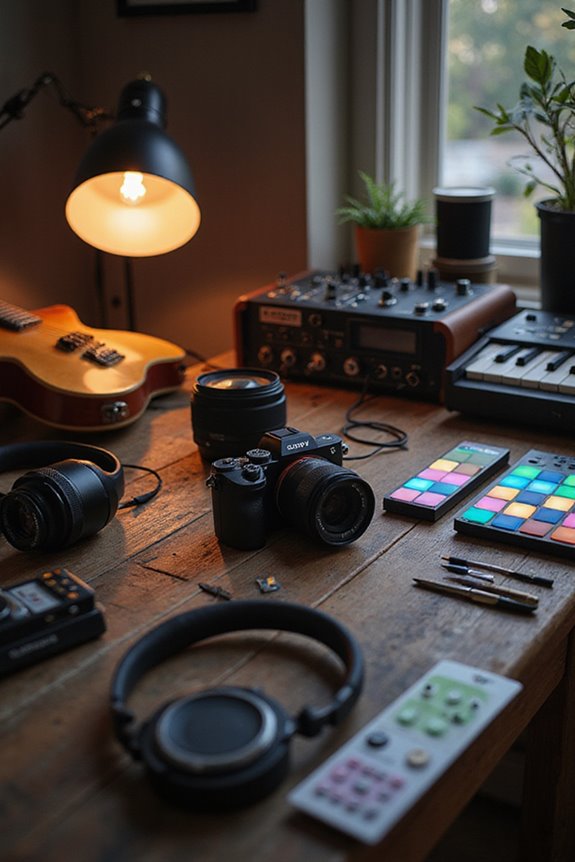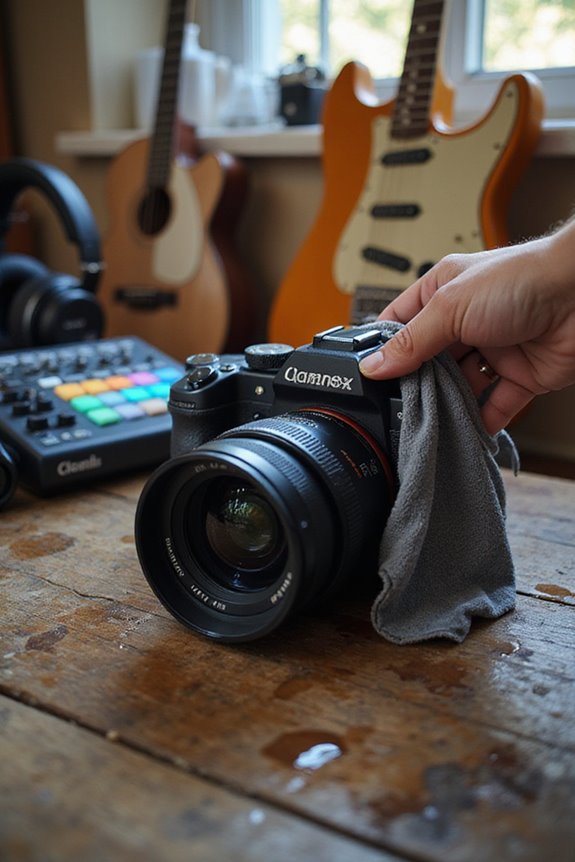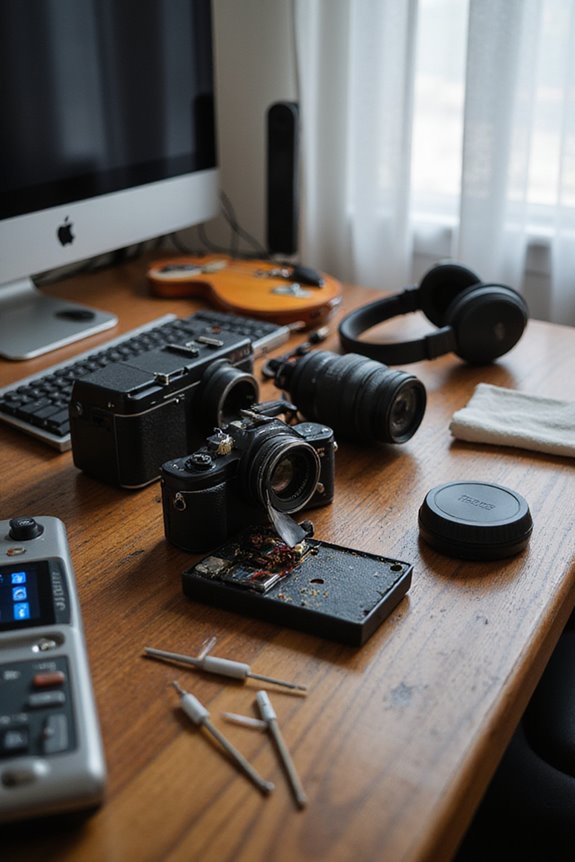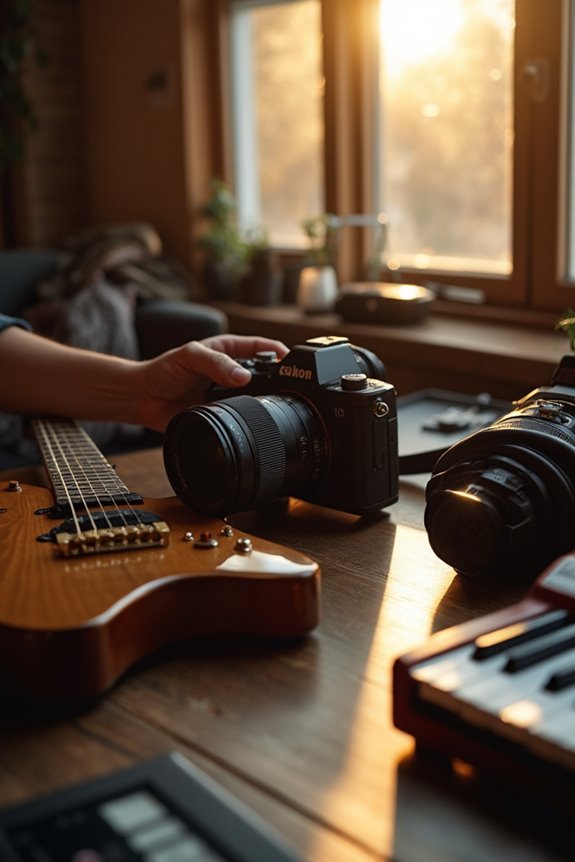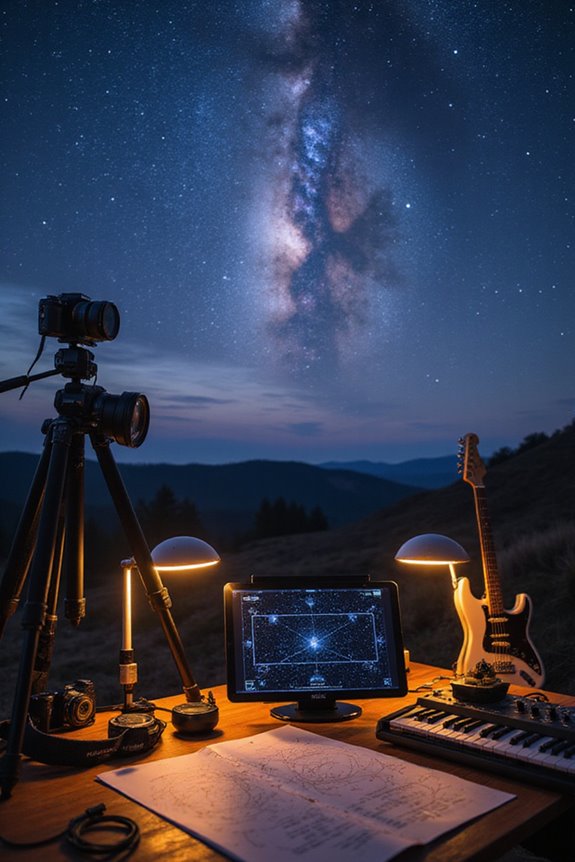To use timecode on video equipment, we start by ensuring all devices support timecode input and output. Next, we can connect them to a centralized timecode generator. This helps synchronize our footage and audio, especially in multi-camera setups. It’s essential to maintain consistent frame rates and calibrate our devices after connection. If we encounter issues like timecode drift, we need to have protocols in place to resolve them quickly. Let’s explore practical tips for effective timecode usage next!
Key Takeaways
- Ensure all video equipment supports timecode input/output to enable synchronization across devices.
- Use an external timecode generator for devices lacking built-in timecode features to maintain precision.
- Connect devices with dedicated cables, centralizing timecode generation for consistent syncing.
- Regularly calibrate the synchronizer after connecting all data sources to avoid drift and ensure accuracy.
- Maintain consistent frame rates across devices to simplify alignment and prevent synchronization issues.
Understanding Timecode Basics
Timecode is a critical tool in the video production world, serving as a unique digital address for each frame in our footage. To grasp the timecode definition, we need to recognize that it’s a sequence of numeric codes, helping us coordinate and sync video and audio recordings. The timecode format displays hours, minutes, seconds, and frame counts as HH:MM:SS:FF. This structure enables precise identification of footage during editing, essential for tasks like logging takes or syncing independently recorded audio. By generating a master timecode signal on set, we make sure all devices stay in sync. This simple practice can considerably reduce our editing time and minimize errors, paving the way for a smoother post-production process.
Types of Timecode Signals
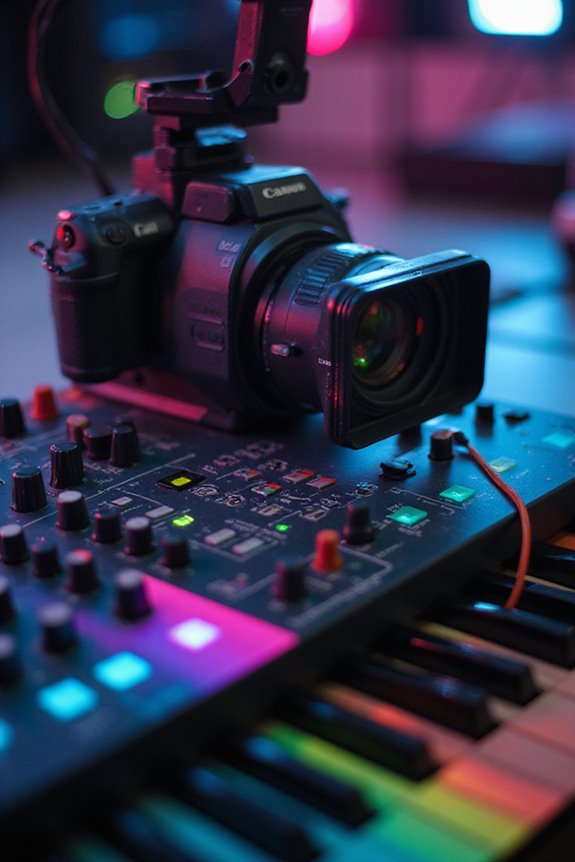
When we talk about timecode signals, it’s important to understand the various types available and how each one plays a role in the video production process. We have Longitudinal Timecode (LTC), which boasts key advantages like being easily jammed across devices for sync. In contrast, Vertical Interval Timecode (VITC) excels in tape-based formats with its ability to read timecode accurately in slow motion. Both formats adhere to SMPTE standards, guaranteeing compatibility and accuracy across different frame rates. Timecode generators, often used on set, provide reliable timestamps, allowing for seamless timecode conversion and jamming methods to guarantee devices stay in sync. These advancements enhance our production efficiency, particularly in complex shooting environments.
Functions of Timecode in Video Equipment
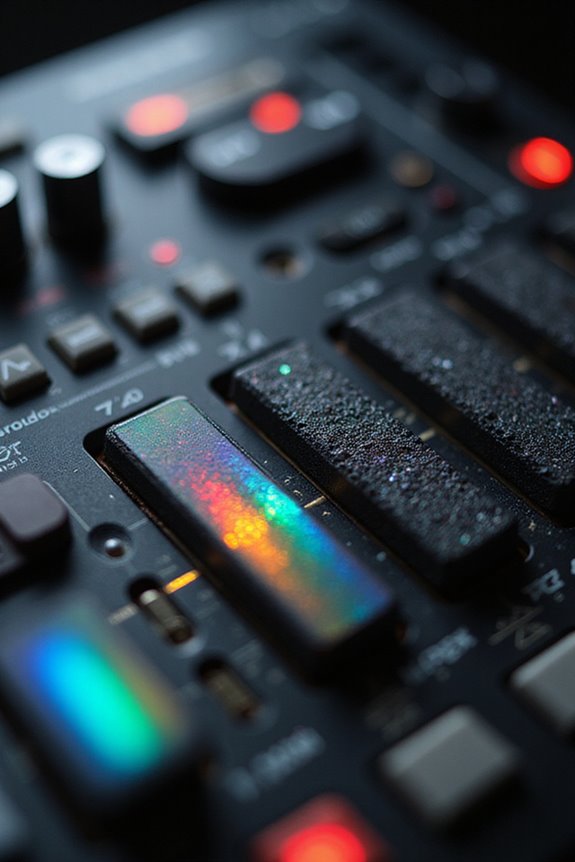
In the world of video production, understanding the functions of timecode can greatly enhance our workflow and efficiency. The timecode benefits include providing a unique digital address for every video frame, allowing us to locate and reference specific clips quickly. This precision enables seamless navigation through long footage, making post-production less time-consuming.
Timecode applications extend to synchronizing audio and video tracks, ensuring they stay perfectly aligned, especially during multi-camera shoots. It helps streamline our editing process by embedding time markers into media files, organizing footage logically, and allowing for software automation. Ultimately, these functions not only improve our editing speed but also elevate the quality of our final product, minimizing errors and maximizing productivity.
Setting Up Timecode for Synchronization
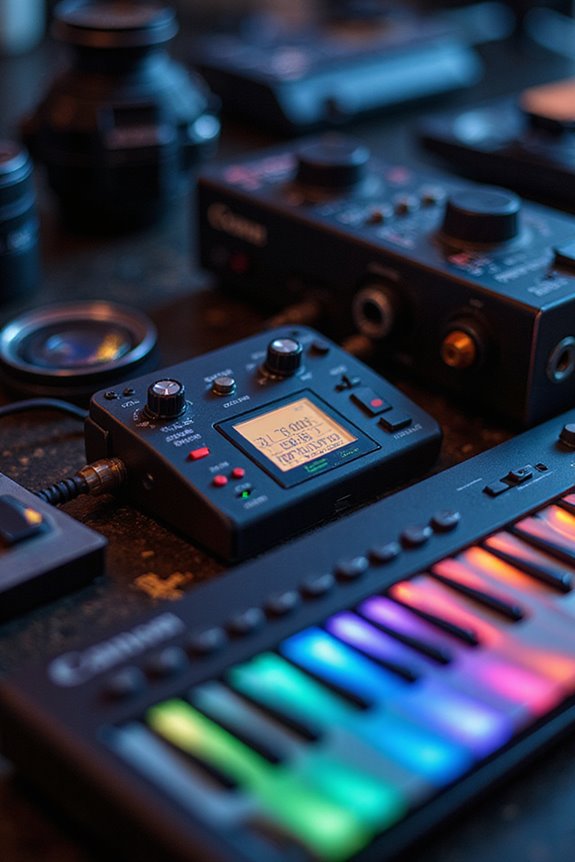
Setting up timecode for synchronization is essential for ensuring that our audio and video elements align perfectly, especially in complex productions. First, we need to confirm that all our devices support timecode input/output, either directly or via mic input for LTC. For those without dedicated functions, using an external timecode generator like the Deity TC-1 proves invaluable. We should centralize our timecode generation, connecting devices with dedicated cables to maintain timecode signal integrity. Don’t forget to calibrate our synchronizer after adding all data sources, employing effective timecode calibration techniques to adjust for any discrepancies. With consistent frame rates set, we can achieve precise alignment, ensuring smooth editing and playback later on.
Practical Tips for Effective Timecode Usage
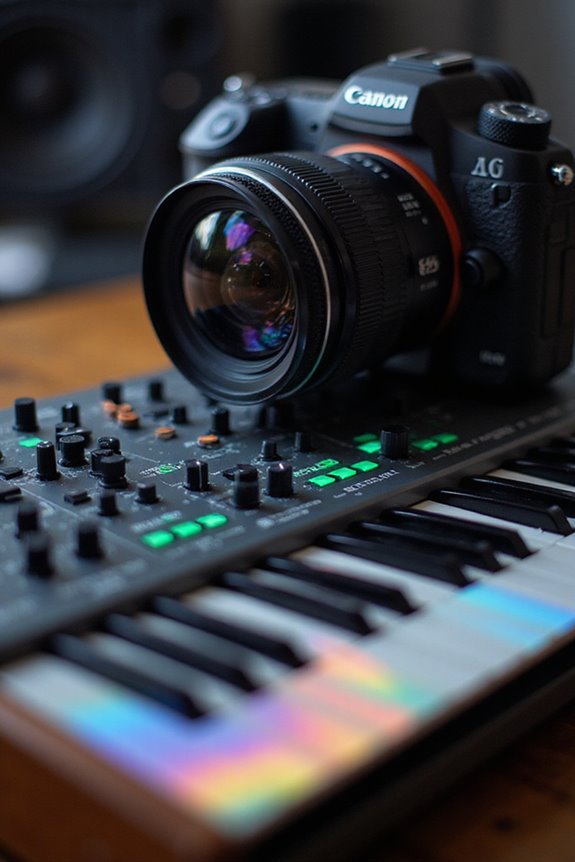
How can we make the most out of timecode in our video projects? By focusing on effective timecode calibration and organization, we can enhance our workflows considerably. First, let’s verify our timecode settings match our camera frame rates to avoid sync issues. Using a physical SMPTE timecode generator guarantees precision, especially in multi-camera setups.
Next, we should embed timecode in our footage, making navigation easier in the edit. Organizing files with consistent timecode metadata streamlines post-production, helping us locate key moments fast. Regularly verifying and calibrating our timecode sources prevents drift, keeping everything aligned.
Finally, utilizing timecode in our daily logs can boost communication and efficiency, supporting a smoother overall production experience.
Common Challenges Faced With Timecode
Maneuvering timecode in video production presents its own set of challenges, even when we’ve implemented effective calibration and organization. One major issue is timecode drift, which occurs as devices, each with their own internal clocks, record over extended periods. If we don’t employ proper drift detection and synchronize our devices using effective synchronization protocols, we risk losing sync between audio and video, especially after long takes.
Additionally, mixing devices with varying frame rates complicates synchronization, leading to further drift complications. Mismanaged timecode signals, particularly when dealing with audio, can result in significant errors. By understanding these challenges firsthand, we can better prepare our setups and execute seamless productions that truly capture our vision.
Solutions to Timecode Issues
When tackling timecode issues, a variety of practical solutions can enhance our production efficiency and accuracy. Using dedicated timecode boxes allows us to generate a common clock, ensuring seamless audio and video alignment. For devices lacking timecode input, utilizing free run timecode mode or recording timecode as an audio channel can be effective workarounds. In our timecode workflows, jam syncing all devices before we start recording helps maintain synchronization. We can also leverage editing software like Adobe Premiere Pro to automate synchronization, making timecode troubleshooting much simpler. Ensuring frame rates match across all our devices is essential; regular testing can catch compatibility issues before they escalate. By implementing these strategies, we set ourselves up for smoother productions.
Leveraging Timecode for Efficient Post-Production
In a world where efficiency in post-production is vital, leveraging timecode can markedly streamline our workflows. Timecode benefits us by enhancing synchronization between multiple cameras and audio devices, eliminating the need for manual cues like claps. This guarantees perfect alignment of clips, which drastically improves post-production efficiency.
When we embed timecode into media files, pinpointing exact frames becomes a breeze, reducing search time and speeding up our editing process. It also simplifies collaboration; timecode serves as a universal language among departments, making it easier to communicate specific moments during review sessions. Additionally, timecode labels provide frame-accurate editing capabilities, essential for guaranteeing precise synchronization between audio and video. Embracing these practices ultimately saves us time and budget.
Frequently Asked Questions
Can Timecode Be Used for Live Streaming Events?
Did you know that around 70% of live streaming events benefit from timecode synchronization? We can streamline our production workflows, ensuring that video, audio, and metadata align perfectly for a seamless viewing experience during live streaming.
How Do I Troubleshoot Timecode Sync Issues During Recording?
When troubleshooting timecode sync issues during recording, we should prioritize timecode calibration and perform thorough sync testing. Ensuring all devices are aligned can prevent frustrating sync problems later in the editing process.
What Frame Rate Should I Use for Different Filming Projects?
When choosing a frame rate, we must consider project requirements closely. Will it be a dramatic narrative or a high-paced sport? Each choice impacts the final feel, so let’s deliberate carefully before deciding.
Can I Use Timecode With Smartphone Cameras?
Yes, we can use timecode with smartphone cameras! By utilizing timecode apps and wireless sync devices, we can guarantee smartphone compatibility and synchronize our footage effectively for multi-camera productions, making our editing workflows seamless.
How Does Timecode Affect Video Compression and Quality?
Timecode greatly impacts video compression and quality control. By ensuring accurate synchronization and frame alignment, we minimize compression artifacts and maintain high quality, allowing our projects to meet professional standards without unnecessary degradation during post-production.

